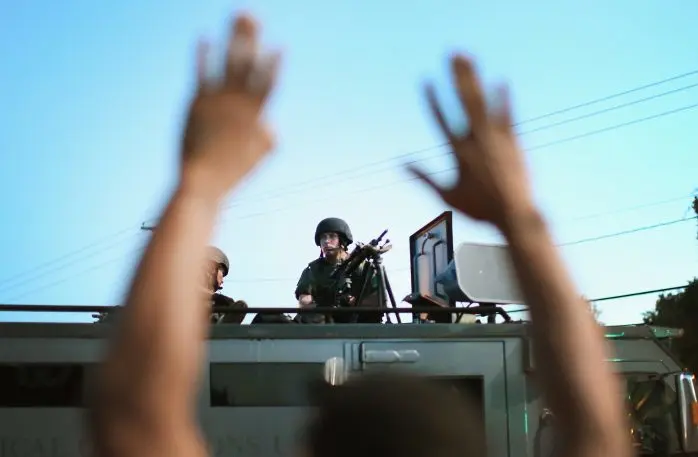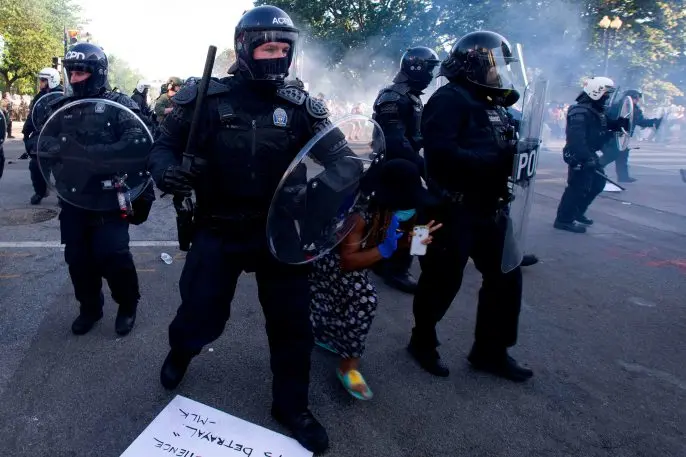As protests over the death of George Floyd intensify across the United States, many police officers aren’t confronting the crowds in their regular blue or black uniforms. Instead, their attire comes off as far more aggressive.
In Minneapolis on Saturday, state police wielded batons and wore helmets with face shields, knee-high boots, and external bulletproof vests. That same evening in Seattle, Washington, members of the King’s County Sheriff’s department patrolled the city in green fatigues, shoulder and knee pads, and what appeared to be gas masks. Similar scenes have played out across the country.

“It looks like a war zone when police officers are wearing dark battle dress uniforms, and they’re joined by the National Guard wearing camo, carrying M14 and M16 rifles,” says Michael Birzer, professor at the school of criminal justice at Wichita State University, and a former police officer. “The police want to project a show of force and one way you do it is just by your sheer presence in uniform.” At a time when distrust of the police is rampant, particularly among black people, these uniforms further strain officers’ relationship with the communities they’re supposed to protect.
The psychological impact of military uniforms
Police uniforms aren’t just utilitarian garments; criminal justice scholars say they’re also designed to project symbolic power. Birzer points out that the original navy blue police uniform was designed to give the impression of safety and competence, whereas combat uniforms signal the potential for violence. Several studies have found that citizens perceive police officers clad in traditional black or blue as friendlier and more honest than those wearing military-style fatigues that are green or camouflage.
There haven’t been any in-depth studies about whether police who wear military-style garments are more likely to act violently, but Robert Mauro, a psychology professor at the University of Oregon, says there’s good reason for this: Police tend to wear this gear in highly-charged situations such as protests, which makes it hard to know whether the uniform or the context drives the behavior.
But using other psychological studies, Mauro believes uniforms that obscure the face and body are more likely to cause the wearer to act violently. And while police uniforms display the officer’s name on a badge and tend to leave their faces and heads uncovered, military-style uniforms make it harder to identify the person wearing it. This leads to what psychologists call “disindividuation,” which means feeling disconnected to your own identity, including your past and future.
“You lose your connection with your moral upbringing and the impact your actions will have in the future,” Mauro explains. “You end up being more susceptible to situational pressure. Military uniforms disinhibit moral behavior, pulling you toward violence.” (Mauro says anthropologists have found tribes that use more war paint that obscures their faces and bodies are more likely to act violently.)
Mauro says the violence can go both ways. A military-style uniform is likely to dehumanize the officer, making it easier for the protester to act aggressively toward him or her. “What you have now is a faceless enemy; they’re not people anymore,” Mauro says. In other words, combat gear can turn a tense protest into a tinderbox.

Militarized police and black Americans
If the armored vehicles and riot gear used by police forces are reminiscent of war, it’s because some of this equipment was, in fact, deployed by U.S. forces in Iraq and Afghanistan. In 1990, Congress launched the 1033 Program, which offloads surplus military equipment to state law enforcement agencies; in 1997, this expanded to include local police departments. Since then, $5.4 billion of surplus military equipment, including clothing, has gone to local law enforcement agencies.
Proponents believe this equipment reduces crime rates. But new research tells another story. University of Michigan political science professor Kenneth Lowande analyzed inventory records from the 1033 Program and found that giving police more military equipment had “no detectable impact on violent crime or officer safety.”
At the same time, this military-style gear has historically been disproportionately used by police in communities of color. Birzer points out that the start of the 1033 Program dovetailed with the war on drugs. “That’s really when we begin to see police in camouflage, dark BDU [battle dress uniform], and a real militaristic appearance,” says Birzer. “And we now know that that war was fought in poor, minority neighborhoods. It’s going to take a long time for the police to get back the trust in those communities—and incidents of police brutality that we’ve seen in recent weeks don’t help matters.”

Trump has since rolled back these regulations. In fact, he seems to be taking the opposite stance, tweeting for law enforcement to use “overwhelming force” and “domination” in their interactions with protesters. However, there’s still a chance things might change in the years to come. Last week, a bipartisan group in Congress announced hearings on the use of excessive force by law enforcement and some said they would work to reform 1033.
Turning back the clock
Birzer says a widespread return to a more traditional blue or black police uniform—even in the context of crowd control during protests—could help restore trust between citizens and officers. In the United States, the blue uniform worn by police officers goes back to the 1800s and is symbolically different from what we see in many of the current protests. “The way the uniforms were originally conceived was to help people readily identify who was a police officer to seek them out for assistance,” says Birzer. “It wasn’t meant to be threatening.”

Many U.S. uniforms were inspired by the designs of Sir Robert Peel, who created uniforms in 1829 for the Metropolitan Police Service in London, an organization that he founded. Peel developed nine principles of policing that continue to inform departments today; he believed that police should earn citizens’ respect in order to avoid using physical force. Research shows that citizens still associate the traditional dark uniform worn by both American and British officers with less violent forms of policing.
After three decades of equipping police with tools designed for warfare, it seems like an uphill battle to demilitarize police forces. Still, many experts hope we can return to a world where police officers aren’t armed for combat. The bipartisan moves in Congress could signal a willingness to start demilitarizing police departments. It won’t necessarily change the culture overnight, but it’s a start.
Recognize your brand’s excellence by applying to this year’s Brands That Matter Awards before the early-rate deadline, May 3.
